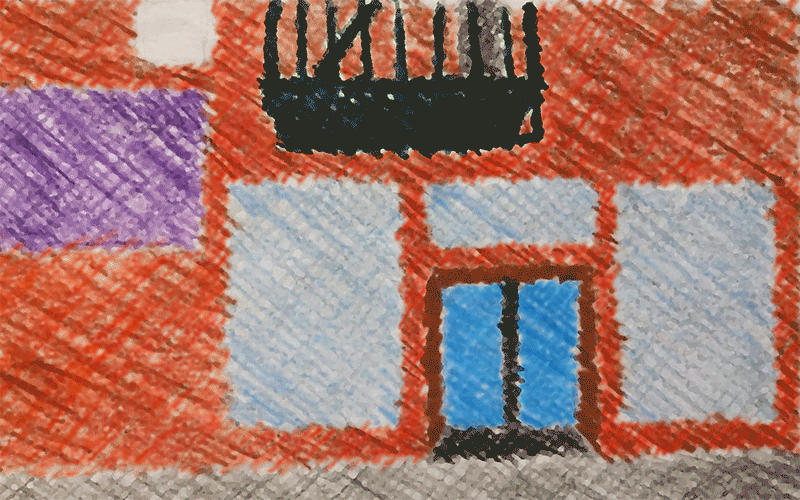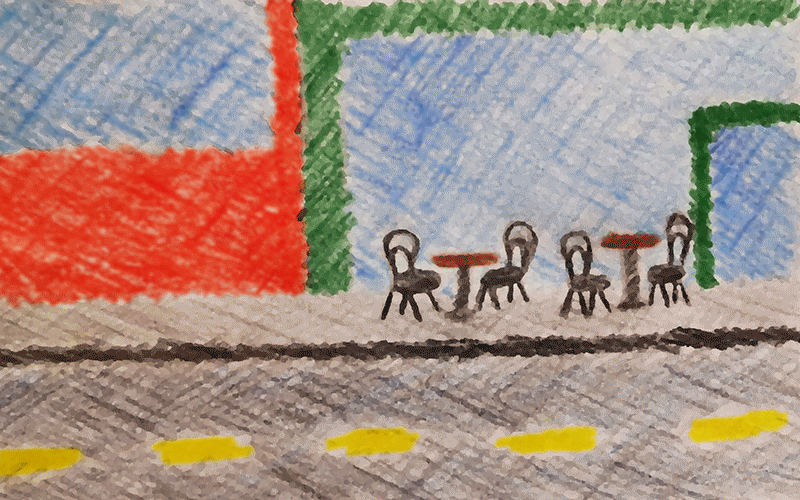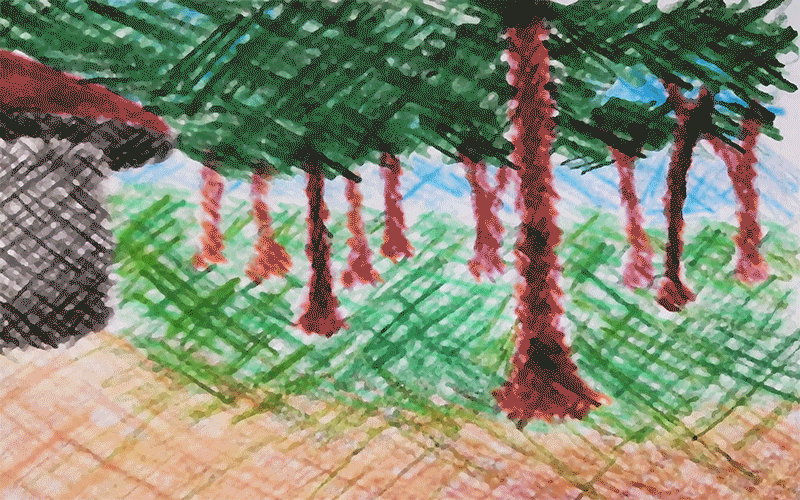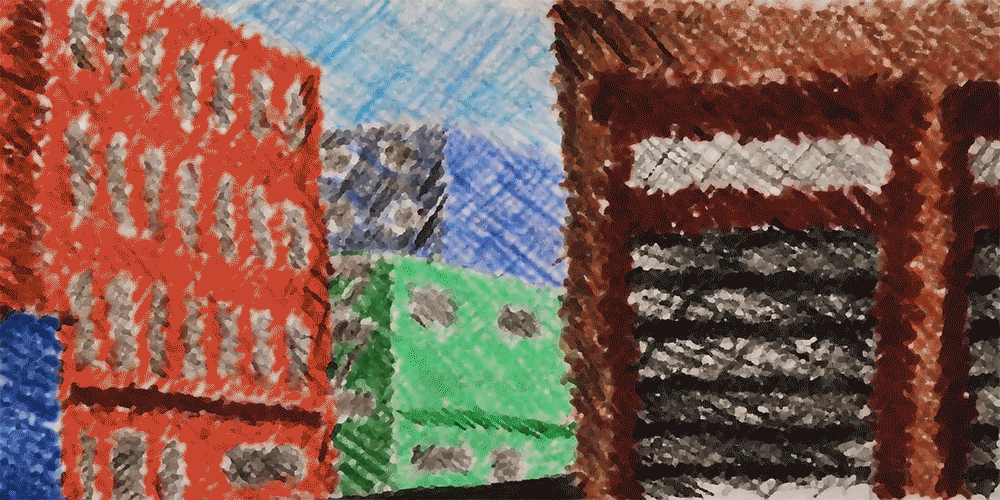Editor’s Note: This essay includes an example of poetry that appropriates problematic language in order to further illuminate and analyze issues of homophobia, gentrification, and ableism.
I don’t want my poems lisped on the numbered tongues of children. May they be part of the world and sight by which we become the eye and defy question.
Frank O’Hara
A couple in matching black walks by, led by a teacup dog in a pink sweater. They pass two middle-aged men, covered in faded face tattoos, chatting under a tree at the entrance to Tompkins Square Park. It’s barely fall on this café corner at 9th Street and Avenue A, and a breeze pushes the summer sun from my skin. Something about the wind on my arm jogs my memory, reminding me of my first visits to this part of Manhattan 20 years ago. I was 15 or 16 then, coming in from the suburbs to find trouble in this once rough neighborhood, to test the boundaries of my world.
These memories layer onto the scene in front of me, as memories often do. Boutiques and renovated tenement buildings become coated with long-since washed-off graffiti and boarded windows. Fresh cut flowers and croissant smells are overrun by sour street-side garbage. My heart even jumps as I remember buying a dime bag of weed around the corner. It’s as if I am there again. Then again. Adrenaline is actually released into my veins. For several seconds — minutes, in fact — I experience the world through multiple times, multiple senses, and multiple memories.
This is the thing with memory. It accumulates, piling up to be remembered whether we ask it to or not, pieced together to create our present. The East Village is home now, and not so rough, but these memories cause my lives to collide, making me wonder about the way we story of ourselves into the world, combining seemingly random bits to create a sense of our self, digesting memory and experience to help us know who we are in this moment, in this place.
Marcel Proust tried to write a seven-volume novel about this very idea called In Search of Lost Time, but he died before he could finish it. It follows an unnamed narrator’s experience with love and art and culture. Proust coined the term “involuntary memory” in it, a term that’s still used in psychology to describe the memories we recall without actually trying to recall them — like a passing scent that reminds you of your ex, or the sound of a chalkboard that reminds you of your middle school teacher’s voice. For Proust, it was a pastry. A madeleine reminded him of his grandmother. He wrote, “No sooner had the warm liquid mixed with the crumbs touched my palate than a shudder ran through me and I stopped, intent upon the extraordinary thing that was happening to me.”
A pastry brought back memories he might have otherwise forgotten. And just as the madeleine caused Proust to wonder about his grandmother and the nature of memory, the sensory overload on Avenue A causes me to wonder about the way these layers create our worlds.

I’ve lived in the East Village for nine years, but when I moved here this café was my spot. Set up like a small Parisian café with cheap furniture, a faux tin-tile ceiling, and outdoor seating, this café on Avenue A symbolized the neighborhood I wanted to live in: mellow, quiet, bohemian. It was just three blocks south of my apartment so it helped ground me in this place and fall faster in love with my image of the city and story I wanted to be a part of.
It’s also the perfect place for people watching while you work. Today, in front of me, is a goateed guy in his mid-30s riding a skateboard. He has on camo cargo shorts, a thin green t-shirt, and a beanie. He pauses occasionally to rest his board against the traffic pole to admire it, but mostly he’s playing in the intersection, trying tricks between moving cars, disrupting traffic. It looks fun. He’s out there by himself, messing around between cars.
The casual danger of it all reminds me of the beginning of another book, astronomer Chet Raymo’s The Soul of the Night, where he watches a young girl get hit by a skateboarder. The moment pauses his world. “Pigeons froze against the gray sky,” Raymo writes, “Promenaders turned to stone. Traffic stopped on Beacon Street.” But as he holds a terrified breath, the cosmos doesn’t pause with him. As the girl flies through the air, he tells us, the Earth’s rotation carries her half a mile to the east, its orbit carries her 40 miles west, and the solar system drift drags her 20 miles toward the star Vega. “There was no protest from the sky,” he says, proof that the cosmos doesn’t care if a child is hit while walking down Beacon.
And just as a single memory made my stomach knot, Raymo’s story now layers onto this place. I half expect a young girl to step around the corner and into this skater’s path.
This is one of the reasons we love to read. It allows characters to set up in our minds and live among our memories. We appropriate them to tell our own, stealing from texts, characters, and histories to create ourselves. They become a part of the way we see as if these stories are another sense.
In fact, recent studies imply that we respond to words in a very physical way. A study in Spain showed that if you hook a person to an fMRI and have them read words like “perfume” or “cinnamon,” their brain lights up the same way it does when they’re actually smelling. In another study, it was shown that when we read metaphors like “the singer had a velvet voice,” our brain tries to feel, and when we read sentences like “John grasped the object,” our brain grabs. “The brain, it seems, does not make much of a distinction between reading about an experience and encountering it in real life,” writes Annie Murphy Paul in The New York Times.
This fact is no surprise to anyone who stays up too late engrossed in a new book. Words bring us to another place and time, echoing and rippling through our lives. They become another way for us to feel, helping us consider new selves.
Sitting across from the winding paths and thick elms and oaks of Tompkins Square Park, my brother Ryan comes to mind. Every time a friend visits from out of town, we walk through the park to our favorite bars or restaurants and Ryan proudly talks them through the 150 years of protests and riots that help define this park.
He tells them about the Civil War draft riots here in 1863, when the poor were being conscripted while the rich paid to stay at home. He tells them about the labor riots in 1874. He tells them about the demonstrations during the Depression, Vietnam War, and Civil Rights movement, and the battle between squatters and police in 1988 when the park had turned into a shantytown village due to poverty and disrepair in the 1970s and 80s. In 1988, the city had had enough. The shantytowns were an embarrassing reminder of homelessness and poverty. But the squatters were given nowhere else to go, so they met the police with chants like “Die Yuppie Scum!” and “Free food, free beer!” And in the middle of the night on August 4th, the New York City police came in with batons swinging.

My brother loves introducing our neighborhood through these stories, weaving in gruesome details to put his listener in the mood. But what’s perhaps most interesting is that Ryan is in marketing — a career centered on talking people into collectively “needing” things to fit a status quo, so by defining his neighborhood through riot and revolt, these stories rewrite Ryan too.
We adapt and revise stories to shape our world. As the O’Hara poem in the epigraph above says, stories become our eye, collecting connections to constantly discover new worlds. Stories disrupt our understanding of ourselves. They allow us to write and rewrite the world again and again.
Even O’Hara’s poem is a rewrite. He pulls from Percy Shelley’s “Hymn of Apollo,” where Apollo claims to be the reason we see ourselves,
I am the eye with which the Universe
Beholds itself, and knows it is divine;
All harmony of instrument or verse,
All prophecy, all medicine, is mine,
All light of art or nature; – to my song
Victory and praise in its own right belong.
One can imagine O’Hara reading this, saying, “I’ll rewrite that self-centered nonsense.” Instead, he turns us all into the eye:
I don’t want my poems lisped on the numbered tongues
of children. May they be part of the world and sight
by which we become the eye and defy question.
O’Hara puts the reader at the center. He’d rather we use words to defy and create.
The skateboarder in the intersection sees me looking and comes over. I give him a nod hello.
“Hey man,” he says, “mind watching my board for a minute?”
“No problem,” I say, as he leans the board against the thin metal rail between us, pausing once more to admire it before heading inside the café.
I hear the prison-style electronic buzz of the bathroom door, and a few minutes later he’s back. He picks up the board by the nose and shows it to me.
“Good looking board, isn’t it?” he asks.
“Yeah,” I say. It’s covered with stickers of punk bands and dragons and another that says, simply, “Anarchy.”
“I just got it in from Cali,” he tells me. “You can tell it’s a good board by the cut. Three pieces of wood, hand-carved, shaped together seamlessly.” He rubs his fingers across the love handles where the core is exposed — three distinct layers of wood. “You can only see it here, where they show it off.” He touches the hourglass sides. “The ride is all about the curve. I’m just trying to decide if it’s too much shape for me.”
He drops the board on the pavement and hops on as it runs toward the street. He’s back out in the intersection, flipping and jumping between slow-moving cabs and pedestrians.
New York City is filled with too many stories. You can pick your own reality through selection, just as I’ve already mixed fiction, nonfiction, poetry, science, journalism, and history. You can pick the city you want to live in.
While my brother leads with revolution, when I tell the story of my neighborhood I lead off with Allen Ginsberg, who lived on my block for 20 years. He died in 1997 and I didn’t move in until 2008, but Ginsberg helps me create my own literary geography, layering his life and words into my personal landscape.
It’s also famous and fun to start with the Beats — not to mention meaningful to my identity as a writer, so I often also tell people that Jack Kerouac lived just two blocks away. William Burroughs stayed with him for a summer and Kerouac and Burroughs wrote a novel in the form of that wonderful childhood game, “Exquisite Corpse” — where one starts a story and the next has to pick up where the first writer left off, then back and forth until they’ve co-created a new, shared-world — a corpse of ideas stacked one upon another. And I love this idea, exquisite corpses layered one on another, stacked with meanings and possibility. Ghosts layered upon ghosts.
Sitting on this corner, looking across Avenue A, it’s easy to bring Ginsberg’s poem “Howl” to mind. Watching two young men in dirty clothes passed out on a park bench, head to head, separated by an armrest, I can’t help but see Ginsberg’s heroine-filled “angelheaded hipsters burning for the ancient heavenly connection.” In fact, when I want to, I can see Ginsberg everywhere, complaining about rising rents and “the tanked-up clatter of the iron regiments of fashion,” laughing at women in bug-eyed glasses and the guys with skinny jeans and gelled hair, staring with wonder at the ads along Avenue A, filled with the “nitroglycerine shrieks of the fairies of advertising and the mustard gas of sinister intelligent editors.” But whether I call on Ginsberg’s ghost or not, now that I’ve read it his world layers onto my own as it swirls down A, spinning through the trees and into this little café.
My literary geography might have started in part with the Beats, but I’ve layered over it again and again. It’s easy to do. This part of Manhattan is home to the Nuyorican literary movement and the mimeograph movement, to New York School poets like Frank O’Hara and the Poetry Project at St. Mark’s Church on the Bowery. It is Sidewalk Café and KGB Bar and the Bowery Poetry Club. It was the heart of the punk rock scene in the ’70s, and Andy Warhol and Jean-Michel Basquiat, as well as hundreds more artists who disappeared into some office building or café counter when their artistry took them no farther than their own imaginations, but whose lives layer onto this geography to their own degree anyway.
Miguel Piñero, the co-founder of the nearby Nuyorican Poets Café, took this deep-rooted link between self and place quite literally. Piñero’s ashes were scattered along these streets after he died in 1988. A bit of his 1985 “A Lower East Side Poem” explains,
So let me sing my song tonight
let me feel out of sight
and let all eyes be dry
when they scatter my ashes thru
the Lower East Side.
From Houston to 14th Street
from Second Avenue to the mighty D
here the hustlers & suckers meet
the faggots & freaks will all get
high
on the ashes that have been scattered
thru the Lower East Side.
Piñero’s poetry lets me glimpse at this neighborhood in a new light. His words are both foreign and mine, offering what once was and what still is. They help me find community in these streets, grounding me. For a moment, at least, I am able to believe that I might set roots as deep as his in this place. Piñero’s words help me write myself into the land. They root me, just as the romantic notion of myself in this café once rooted me.
Across Avenue A, the summer falling trees create a play of shade and shine across Tompkins Park. I watch two women with matching yoga mats avoid colliding with a man in pleated slacks who is talking seriously into a cell phone, pacing back and forth as if he were inside a private office. Kneeling near him, an old woman tears into garbage cans looking for recyclables, and a girl in a short skirt and winter boots smiles as she walks past a man with long gray braids falling down his shirtless barrel chest. On the basketball court behind them, sixty high school boys in ties play and laugh and push.
But I pause as I write this scene. I want to include the multiplicity of race and ethnicity in front of me, but it feels incongruous or incomplete to try. This neighborhood’s diversity of community creates a diversity of self that makes the terms multi-racial and multi-cultural feel clunky. There is history in the faces, streets, fashions, and architecture around, but you’d have trouble separating them. It is far too complex for such a task.
The history of this place is overwhelming, in fact, as all histories are, but the pace of it here is astonishing. Just 400 years ago this neighborhood was swampland north of a Lenni Lenape village, but as European settlements grew through the 17th Century, “Peg-legged” Peter Stuyvesant filled the swamp in for farmland. Over the next century, as New York’s port grew, Stuyvesant’s descendants parceled this land into wealthy townhomes. German immigrants flooded it next, calling it Kleindeutschland, “Little Germany,” transforming the land into factory-fed slums in the mid-19th Century. Eastern European Jews and Irish and Italian immigrants moved in next as the city center grew north throughout the industrial boom of the late-1800s. This part of the city was still called the Lower East Side then, until returning World War II GIs and the Beats and bohemians took over the northern section, renaming it the “East Village” to associate it with the artsy Greenwich Village rather than factory slums. And in the 1970s, the poet Bimbo Rivas renamed part of it Loisaida — the Spanglish version of the Lower East Side — alongside the Nuyorican writers like Miguel Algarín and Miguel Piñero. Rising crime rates in the 1980s brought in the name Alphabet City for Avenues A to D before increasingly wealthy crowds of artists, musicians, NYU students, and art-minded hipsters and yuppies re-asserted the name East Village to tie it to the wealthier center.
I pass over many more histories — the Yippies and Zippies, the Arab and Bengali immigrants, fluctuating waves of homeless people and crust punks, and so many movements and groups that even the longest of histories couldn’t do it justice. I blur overlaps to make it easier, focusing on the major intersections in history to simplify things.
History is often presented like this, of course — grand intersections and static structures rather than a nuanced collection of people and moments. It is always edited, but the unspoken layers remain. You can see them in faces and fashions, in Shakespeare’s words and Kerouac clothes. Not everyone leaves. Fashions recycle and histories are lost and remembered. And while social policies like rent control and rent subsidies slow change, it doesn’t explain why you seem to be able to see 400 years continue to walk these streets.

Sitting along this park, if I choose, I can watch Germans stroll toward Kleindeutschland, NYU students study in the café, or beats and bohemians ease out of their flophouse hangovers. I can watch Eastern European Jews walk home from a long day in the factories or a Bengali cabbie walk from the mosque on First Ave to sit in Tompkins’s sun. Even seemingly erased histories, like the Lenni Lenape, are not entirely gone, popping up in names like Manhattan, “the island of many hills” in a language that is now extinct, aside from a few small, meaningful breaths.
The poet James Merrill laments that “everything in this city is torn down before you had time to care for it.” He writes, “the sickness of our time requires that everything be blasted in its prime,” but I’m not sure about that. Sitting on this corner, I swear I see Peg-legged Peter Stuyvesant walking down Avenue A in his broad-laced collar and linen breeches. He seems confused, wondering where all of his descendants have gone, and why they’ve allowed so many thousands to take over the beautiful country farm he’d flattened so many hills to build.
The waitress walks over to my table and asks if I need anything else. I do not and ask for the check. This is the third time she’s come over, and she’s already cleared my dishes. Without dirty dishes in front of me, I look like a vagrant, sitting on the café’s property as if I’ve not bought anything. Her actions are intentional. The place is only half full, but she is looking to turn the table anyway, to open it up for someone who will buy something now, not someone who finished his lunch an hour before. And with the minimum wage for wait staff at a mere $5 an hour, there is a personal benefit for her pushing. She works for tips, not wages.
This is the current Manhattan story, the efficient American story, and this is why this café is no longer my spot. Rents have risen, or times are tougher, or culture has simply shifted, but whatever the cause, this place has turned from a small bohemian café into an efficient business during my time here. Prices were slowly hiked, the Wi-Fi was cut, half of the café was turned into a leather-booth wine bar, and they switched from self-service to table-service. Each move was meant to squeeze more dollars and move more people through.
Of course, I am partly to blame for this shift. By moving here and living in a renovated tenement building — paying more — I push up the demand for this neighborhood. I help justify raised rents. Simply by moving here, I contribute to the death of the dream I chased here. I layer on a new reality, whether I want to or not.
I pay my check and decide to walk through the park before heading home. I wander into the maze of ambling paths through the sectioned park, past casual musicians. Children play in the playground as couples cuddle on picnic blankets. Squirrels run in front of my feet.
I turn up another path, but my stride slows. Walking toward me, a woman in a long, flowered, cotton dress. She has on tall leather boots and a bohemian knit hat. She walks like she’s dancing with the leaves, smiling at the sky. With Whitman’s words on my breath, I am love-flesh tremulous, watching her face, her limbs, in mystic deliria from head to foot. She nears me, and her eyes find mine. The moment extends to the back of my skull, down my spine, into my chest, into my stomach. I feel the rush of the poem of Whitman’s desire, the aching rivers of his “Song of Myself,” his epic American tale, seeking something yet unfound, some new truth in the quest for a song of a fitful soul. The city melts around me as the moment of our linked eyes extends and expands. I am lost in time, free and lawless, a furious storm careening through me. I am left with only one thing to do. To take action. To be the protagonist of my own narrative.
I open my mouth to say hi, and begin a new story. •
This page uses modified photographs “Tompkins Square Park Riot Reunion Shankbone 2012” by David Shankbone and “Chico-1988-nyc-low2” by Goldsztajn under the Creative Commons Attribution 3.0 Unported license.




